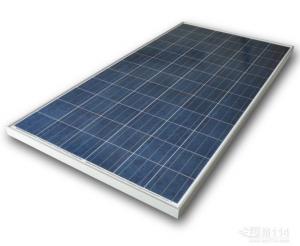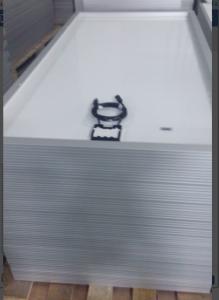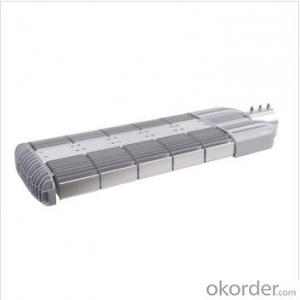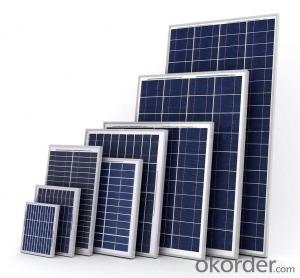High Efficiency Polycrystalline Solar Panels 235w - Solar Panels and Parts
- Loading Port:
- China main port
- Payment Terms:
- TT OR LC
- Min Order Qty:
- 1000 watt
- Supply Capability:
- 1000000 watt/month
OKorder Service Pledge
OKorder Financial Service
You Might Also Like
Specification
Introduction of Poly solar panels CNBM
Polycrystalline Solar Panels 235W With High Efficiency
CNBM Solar photovoltaic (PV) Panel is designed for large electrical power requirements. It is the optimal choice for both on-grid and off-grid power systems. CNBM Solar panel offers high performance of power per square foot of solar array. Monocrystalline silicon(c-Si): often made using the Czochralski process. Single-crystal wafer cells tend to be expensive, and because they are cut from cylindrical ingots, do not completely cover a square solar cell module without a substantial waste of refined silicon. Hence most c-Si panels have uncovered gaps at the four corners of the cells.

Feature
1.Solar Cell : High efficiency crystalline solar cell. Even if under the weak light, the solar module can produce maximum power output.
2.Tempered glass (toughened glass): Anti-reflecting coating and high transmission rate glass increase the power output and mechanical strength of solar module.
3.EVA and TPT: Using high quality EVA and TPT to prevent destroying and water.
4.Long lifetime: ≥25 years; Less power decrease.
5.Resisting moisture and etching effectively, not effected by geology.
6.The certificate issued by international authority: UL, TUV, IEC, VDE, CE.
Specification
Characteristics of Poly solar panels CNBM | |||||
Max Power Voltage Vmp(V) | 30.3 | 30.8 | 31.1 | 31.4 | 31.85 |
Max Power Current Imp(A) | 7.60 | 7.64 | 7.73 | 7.81 | 7.85 |
Open Circuit Voltage Voc(V) | 36.1 | 36.6 | 37 | 37.3 | 37.68 |
Short Circuit Current Isc(A) | 8.50 | 8.55 | 8.65 | 8.75 | 8.85 |
Max Power Pm(W) | 230W | 235W | 240W | 245W | 250W |
Temperature Coefficient of Cells Poly solar panels CNBM | |
NOCT | 45℃ ± 2℃ |
Temperature Coeffucients of Isc (%/℃) | 0.0492 |
Temperature Coeffucients of Voc (%/℃) | -0.3374 |
Temperature Coeffucients of Voc (%/℃) | -0.4677 |
Mechanical Data of Poly solar panels CNBM | |
Dimension | 1638 × 982 × 40 mm |
Weight | 19.5 kg |
No. of Cells and Connections | 60 (6 ×10) |
Tolerance | 0 ~ + 5 W |
Cell | Monocrystalline Cell 156 × 156 mm |
Packing | 624 Pcs/40ft(H) Container |
Limits of Poly solar panels CNBM | |
Operating Temperature | -40℃ to +85℃ |
Storage Temperature | -40℃ to +85℃ |
Max System Voltage | 1000VDC(IEC) / 600VDC(UL) |
Guarantees of Poly solar panels CNBM | |
Products Guarantee | 12 yrs free from defects in materials and workmanship |
Performance Guarantee | No less than 90% within 10yrs and no less than 80% within 25yrs |
Certificates | TUV(IEC61215&IEC61730),VDE(IEC61215&IEC61730),UL,CE |
Packaging Information
Package:26pcs/box
Quantity:1 box/pallent
Loading Capacity:952pcs/40ft
- Q: What is the efficiency of modern solar panels?
- The efficiency of modern solar panels varies, but on average, it ranges from 15% to 20%. Some high-end panels can achieve efficiencies of up to 25%. However, it's important to note that the efficiency of solar panels is constantly improving as technology advances.
- Q: I have a 500 watt inverter and battery but need solar panels to run my need. I want to have enough juice to run a computer and monitor and sometimes a 5w amp. I am not sure how much power is needed to run the computer (standard desktop with 5flat screen with an additional surround sound system) though on the side of the computer it says 5 amp but I know I used to run it and monitor and surround sound with a heating blanket on the same circuit which was rated at 20 amps. My question is that I would like to go and buy some panels (cheaply as I'm unemployed) from somewhere like Harbor Freight that would meet the need of the converter to supply enough amperage. So what size panel(s) or panels would I need to run this setup? If I am correct I think 500 watts is equal to 5 amps. Would this even work? Could I run a partial system where I could run some of the stuff to take a load off? I need to lower my electric bill somehow. Thanks!
- Solar okorder in their survival discussion in the archive, this exact project was discussed at length.
- Q: What is the average size of a residential solar panel system?
- The average size of a residential solar panel system varies depending on factors such as energy needs, available roof space, and budget. However, a typical residential solar panel system in the United States is around 5 to 6 kilowatts (kW), which usually consists of around 15 to 20 solar panels.
- Q: How do solar panels affect the overall energy consumption of a building?
- Solar panels can significantly reduce the overall energy consumption of a building by generating clean and renewable electricity. By harnessing the sun's energy, solar panels provide a source of power that displaces the need for fossil fuel-based electricity from the grid. This not only helps to lower energy bills but also reduces the building's carbon footprint, making it more sustainable and environmentally friendly.
- Q: i hav e a project for school we need to calculate cost to buy and install solar panels in our school
- It operates itself, except if there is a problem. It costs a lot to buy and setup. Some solar panels move to track the sun- the tracking equipment is complicated and needs maintenance. Some solar power systems have banks of batteries to store the energy- those wear out eventually. Some solar panels feed into the power grid, and there is a cost associated with managing that power- paid by the power company.
- Q: I just moved into somewhere with solar panels but don't really understand them...all I know is that they heat the water.Do I still have to turn the hot water on with the solar panels or do they heat it automatically or do they store the energy until I turn on the hot water?!
- Custom solar-heating systems are unique. Does yours have a circulating pump? Does it have a storage tank? Is the fluid that goes to the panels separated from the household water and transfers heat through a heat-exchanger radiator, and the fluid has antifreeze in it? If it does, is the antifreeze of the variety that won't poison your family if there is a leak? Does your system have a thermostat-controlled pump that turns on when the water in the panels are hot? Does it have a limit-thermostat to turn off the pump when water in the storage tank is hot? There are many more variations to operation of solar-heating panels. Find out who designed it or who knows how to operate it and ask them.
- Q: if so, would it be possible to make (or remake) an organism that could subsist off of sunlight and external heat like plants?
- There are, in fact, protozoa that use chlorophyll to harvest sunlight, but the thing is, they also MOVE. So it's not entirely unreasonable that an animal cell could do the same.
- Q: cheapest price for a 20 watt solar panel sold on line
- If okorder /... , cost $75 each. I haven't personally tried that product, but the company has been around for a long time, and is not a fly-by-night. If it has to last, there are dozens of places online that will sell conventional sealed panels. Expect to pay $2.00 a watt on up nowadays.
- Q: Can solar panels be installed on the ground instead of a roof?
- Yes, solar panels can be installed on the ground instead of a roof. Ground-mounted solar panels are a popular alternative when roofs are not suitable or available for installation. Ground-mounted systems offer flexibility in terms of placement, orientation, and size, making them an excellent option for maximizing solar energy production.
- Q: how to market solar energy products?
- It depends upon your product. If it is a solar panel, I want to know if it is a photovoltaic panel or a thermal panel. If you don't know enough to know the difference for your question it might be somewhat difficult to suggest others should buy them. Products have to be marketed to a need either already felt or not so apparent. Photovoltaic panels supply an electric need and will offset electrical usage or may supply the grid if there is excess power. A discussion of payback periods including property values will be needed in any event. Thermal panels supply heat and hot water. They are more efficient than photovoltaic panels and will give faster payback times. (are cheaper) If you are a bit more specific more information may be possible.
Send your message to us
High Efficiency Polycrystalline Solar Panels 235w - Solar Panels and Parts
- Loading Port:
- China main port
- Payment Terms:
- TT OR LC
- Min Order Qty:
- 1000 watt
- Supply Capability:
- 1000000 watt/month
OKorder Service Pledge
OKorder Financial Service
Similar products
Hot products
Hot Searches
Related keywords

























